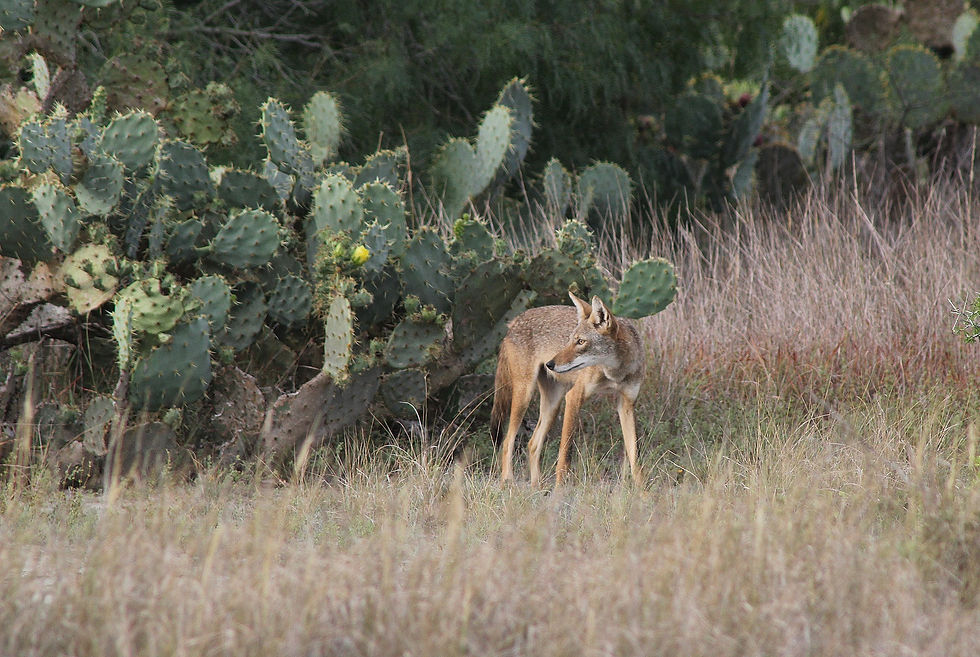Annova LNG submits official application to pave paradise
- savergvfromlng@gmail.com
- Jul 29, 2016
- 4 min read

Last week Annova LNG officially filed their application with the Federal Energy Regulatory Commission (FERC). That means the clock is ticking on filing motions to intervene for any individual or group that will be directly impacted. Only intervenors will be able to challenge FERC's decision the Annova LNG project. Motions will be accepted by FERC until Tuesday, August 17 at 5:00 pm Eastern Time. You can find out more about becoming an intervenor on our intervenor help page.
Here's the bad news about Annova LNG:
The Worst Possible Place for Heavy Industry
The land Annova LNG has leased for its LNG export terminal encompasses 650 acres of the Loma Ecological Preserve. Lomas on the preserve have been called “miniature Galapagos Islands” and are such critical wildlife habitat that until recently Annova’s LNG terminal site was leased by the U.S. Fish and Wildlife as a part of the wildlife corridor. A 1998 survey found a federally endangered ocelot on the site, and it is believed it continues to provide habitat for the species. After Fish and Wildlife pointed out that the plant would directly block an under-highway wildlife passage, Annova agreed to move the footprint of their plant over just 850 feet to the east. But it's questionable whether ocelots, wary of the noise and lights of the plant, would actually use this thin strip of land Annova is allowing for their travel. And the project remains tremendously damaging to ocelots and other wildlife. Fish and Wildlife has said that the permanent loss of wildlife habitat to LNG would result in "a major impact to the already fragmented habitat surrounding the area."
Destroyed Wetlands and Water Pollution
The Annova site contains numerous wetlands that will be filled in, as well as starkly beautiful coastal prairie and dense brush that will be bulldozed and paved over. It’s also directly across from the Bahia Grande, among the largest wetlands restoration projects in North America. Annova plans to dredge a turning basin and widen the ship channel in front of the Bahia Grande Restoration Channel. Dredging increases turbidity and can stir up toxic sediments.
Fouling the Air of Our Coastal Communities
Because the pipeline quality natural gas requires further refining before undergoing the liquefaction process, the Annova LNG export terminals will produce emissions such smog-forming nitrogen oxides and cancer-causing volatile organic compounds. The prevailing winds in the area blow out of the south-southeast. This means that more often than not, the pollution will be blowing across the homes, businesses and schools along Highway 100. The proposed LNG complex is on track to be the largest polluter in Cameron County.
A Record of Pollution
Annova LNG is owned by Exelon, the same company which owns the Three Mile Island Nuclear Plant. In 2006, it was revealed that Exelon had failed to report multiple instances of radioactive tritium leaking into the groundwater during a decade of operating the Braidwood Nuclear Generating Station in Illinois. In 2010 they paid more than $1 million to settle lawsuits arising from over two dozen leaks of tritium at three Illinois nuclear power plants.
LNG Threatens Our Existing Jobs
The massive industrialization and pollution that LNG will bring could erode important economic drivers such as commercial fishing, shrimping, and beach and nature tourism. Thousands of jobs here in the Rio Grande Valley depend on clean air, clean water and high quality fish and wildlife habitat. The lights and fiery flare stack will light up the sky within sight of South Padre Island’s beachfront hotels and condos, and the smog-producing emissions will foul the air. Those are not the sights and smells that draw tourists.
LNG Processing and Transport Is Inherently Risky
Liquefying natural gas requires large quantities of volatile fuels such as propane and ethane which are used as cooling agents. These fuels have a long history of causing explosive industrial accidents, but in the presence of enormous quantities of very concentrated methane, any accident could be catastrophic. That is why accidents at LNG plants have require the evacuation of people up to 3 miles away. When LNG is spilled evaporates and can form an odorless flammable vapor cloud that can drift for some distance. If the cloud encounters an ignition source it will burn back to the LNG spill. LNG fires burn so hot that first responders cannot approach.
Annova LNG Will Not Pay Their Fair Share of Taxes
Annova LNG’s parent company has opposed the Federal Wind Production Tax Credit, saying that, “Exelon has long believed that there is no need to promote subsidies for proven technologies," but that has not stopped Annova LNG from seeking to avoid paying local taxes. They have asked the Point Isabel ISD school district for an abatement worth an estimated $195 million, and the Cameron County Commission is considering a significant tax abatement, ensuring that Annova LNG’s profits will go to distant shareholders instead of roads maintenance and other county services.
More Dangerous and Dirty Fracking
The Energy Information Agency estimates that 60 percent to 80 percent of U.S. gas exports will come from a ramp-up of production. Three-quarters of that new production would come from shale through horizontal drilling and fracking. Building LNG terminals in the Port of Brownsville would therefore lead to a tremendous increase in fracking in the Eagle Ford Shale region, with devastating consequences. Already rural south Texas is being transformed into an industrial zone. Scarce Texas water resources are being depleted, and in some instances permanently contaminated, and the pollution associated with fracking is making people sick. Increased seismic activity has followed the expansion of fracking, and is increasingly being linked to fracking in general and injection wells in particular.

































Comments